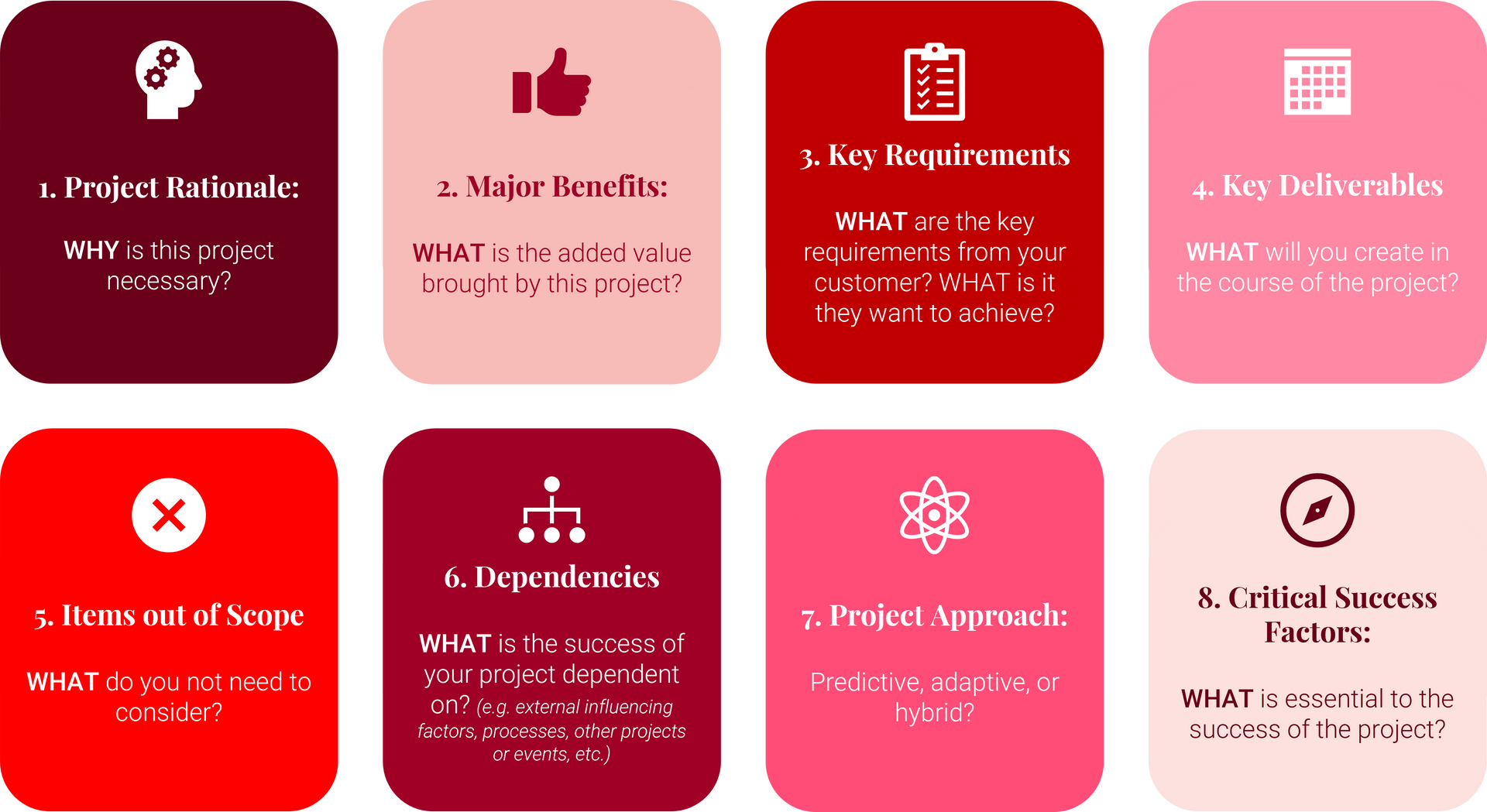Change Management - Execution
Lets Get Things Done
Thus far in our Change Management series we have covered the nature of Change Management, how to initiate it within an organisation, and what to plan for. Now, in our fourth instalment, it is time to translate this preparation into action.
Successful project execution requires a well-defined project management methodology, appropriate tools scaled to the job, effective communication, and a monitoring mechanism to ensure that changes are implemented on time and within budget.
At Cambridge Management Consulting, we emphasise four stages for completing a holistic Project Management and PMO exercise:
- Scope Management
- Project Management Methodology
- Project Management Tools
- Institutionalisation Methods
Scope Management
Scope management is rarely given the consideration it deserves, but provides a unique opportunity to define the boundaries of our project, capturing not only what will be done, but also what lies outside the scope of our activity. One way to identify these components is through a scope document, capturing key criteria in a one-page overview:

This scoping activity helps to address the most prominent disruptor of timelines and budgets: Scope Creep. Scope Creep is a universal factor to be considered; even during digital or complex transformations, it is a realistic risk. However, a well-defined Scope document allows us to revisit what has been agreed, and undertake an impact assessment associated with additional requirements, identifying cost, timeline, and resource impacts. Uncontrolled Scope Creep is unacceptable, an intentional and agreed growth of the scope of the project is far more palatable, especially for project leaders requesting additional funding.
A key contributor to Scope Creep is the project management methodology being used to support the activity.
Project Management Methodology
Agile and Waterfall represent the 2 major project management methodologies, being available in various forms and implemented to varying degrees in most companies.
Agile
Agile provides an adaptive approach with an emphasis on flexibility, iterative development, and collaboration, aligning well with fast-paced business environments where the end goal is less well defined. Even so, you must be careful: Agile done well is an excellent means to deliver results, but Agile done poorly is one of the key sources of Scope Creep and the reason projects miss their targets. When sprints, measures and outcomes are not rigorously defined and supported by a strong coordinating mechanism across the vendor landscape, it is easy for projects to spiral.
Issues that can manifest in Agile project deployment include:
- Uncertainty in Planning: Agile is iterative and adaptive, which can make long-term planning challenging. This uncertainty can be a drawback for projects that require strict adherence to deadlines and budgets.
- Resource Intensive: Agile projects often require active participation and collaboration from team members, and maintaining this level of involvement can be resource-intensive, potentially leading to burnout.
- Lack of Documentation: Agile prioritises software solutions over comprehensive documentation. While this can speed up development, it may pose challenges for future maintenance and knowledge transfer.
- Resistance to Change: Some team members or stakeholders may find it challenging to adapt to the Agile mindset, particularly if they are accustomed to traditional, more linear project management approaches.
- Dependency on Team Collaboration: Success in Agile often hinges on effective collaboration. If team members struggle with communication or collaboration, it can impede the efficiency and effectiveness of Agile processes.
- Incompatibility with Certain Projects: Agile may not be the best fit for projects with well-defined requirements, fixed budgets, or regulatory constraints. In such cases, a more structured approach like Waterfall may be more suitable.
- Lack of Predictability for Stakeholders: Traditional project management provides a clearer roadmap for stakeholders. Agile's adaptive nature may be less predictable, which can be a concern for stakeholders who prefer a more structured approach.
Waterfall
Waterfall project methodology, though considered more traditional, offers distinct benefits for projects with predictable outcomes. Its linear, sequential structure ensures clear project progression and improves project visibility.
Personally, I am a huge fan of well-documented projects that allow the integration of multiple vendors into clear dependency maps. The creation of strict timelines in an easy to communicate document that consolidates various suppliers is a huge step in the right direction. Moreover, it simplifies project management, making it an ideal choice for straightforward, predictable projects where a step-by-step approach aligns with organisational needs.
At Cambridge MC, we feel both Agile and Waterfall have their place, but a hybrid model that combines the agility of Agile with the documentation structure of Waterfall represents the most comprehensive solution to successful project delivery.
Project Management Tools
Depending upon the complexity of the project, it may become necessary to leverage a number of project management tools. However, some tools are universal and non-negotiable.
- GANNT Charts: It is surprising how many project managers are not using GANNT Charts. A single source of truth, capturing a granular breakdown of activities, dependencies, and progress tracking should be the backbone of all projects.
- RACI Matrix: A RACI matrix streamlines project communication, enhances accountability, clarifies roles, and ensures efficient collaboration by delineating responsibilities for each project task.
- Risk Management Registry: Risks should be proactively identified at all stages of the project. A risk registry should be used to log, track, and analyse project risks to enhance proactive decision-making and the development of mitigation strategies.
- Communication Plan: Communication plans foster clarity, reduce misunderstandings, ensure timely information exchange, and enhance collaboration, improving overall project efficiency and success.
- KANBAN Board: Kanban boards optimise workflow, visualise tasks, prioritise work, enhance team collaboration, and promote continuous improvement for streamlined project management.
- Resource Management Matrix: Budget and resource constraints are a critical component of all project deliveries, ensuring that your project is delivered on time, on scope and on budget.
Institutionalisation
Any execution plan is only as good as the ability to institutionalise the change within the fabric of the organisation.
Complex change activities will often necessitate the transformation of key critical technologies, systems, and processes, requiring the development of new governance mechanisms and personnel competencies.
As part of the execution process, a significant amount of time should be devoted to the institutionalisation of the program through front-line managers, typically involving training, workshops, town-halls and other means for communicating the change. Change communication should be communicated as easily digestible bite size components that cascade down the organisation hierarchy one step at a time. During this adaptation process it is important to create the connection between the change imperative and organisation success.
Conclusion
Our execution activity is the culmination of our Initiation and Planning activities, providing the project management teams the tools they require to deliver the change initiative in an effective and organised way that considers risk at all stages of implementation.
In our next instalment, we will cover how to keep your projects on scope, on budget and on time in the Control Phase.
Contact us to identify how Cambridge MC’s Change Management methodology can act as the critical enabling mechanism to support your projects success.
About Cambridge Management Consulting
Cambridge Management Consulting (Cambridge MC) is an international consulting firm that helps companies of all sizes have a better impact on the world. Founded in Cambridge, UK, initially to help the start-up community, Cambridge MC has grown to over 150 consultants working on projects in 20 countries.
Our capabilities focus on supporting the private and public sector with their people, process and digital technology challenges.
For more information visit
www.cambridgemc.com or get in touch below.
Contact - Africa
Subscribe to our insights
Blog Subscribe











